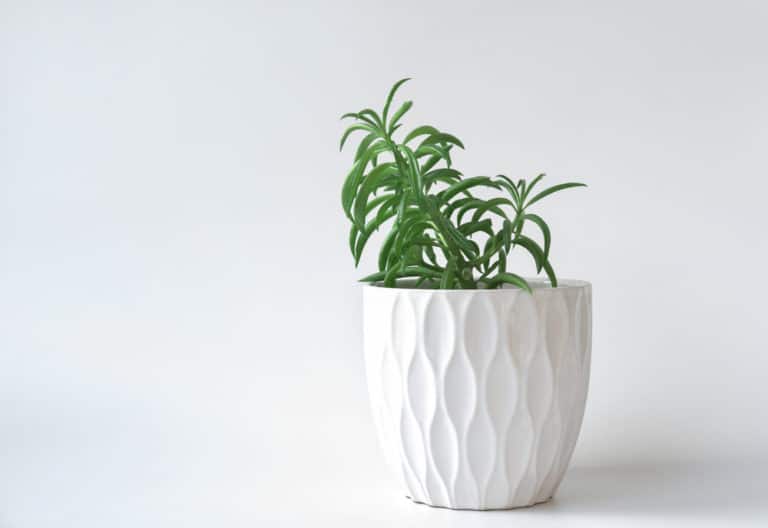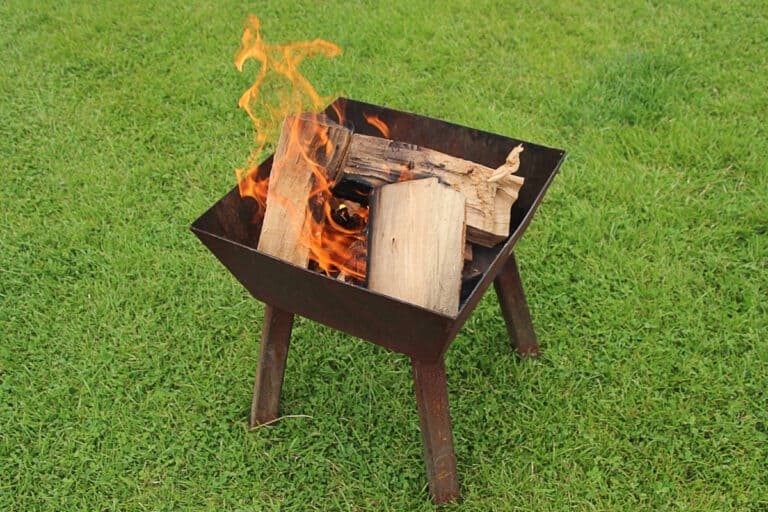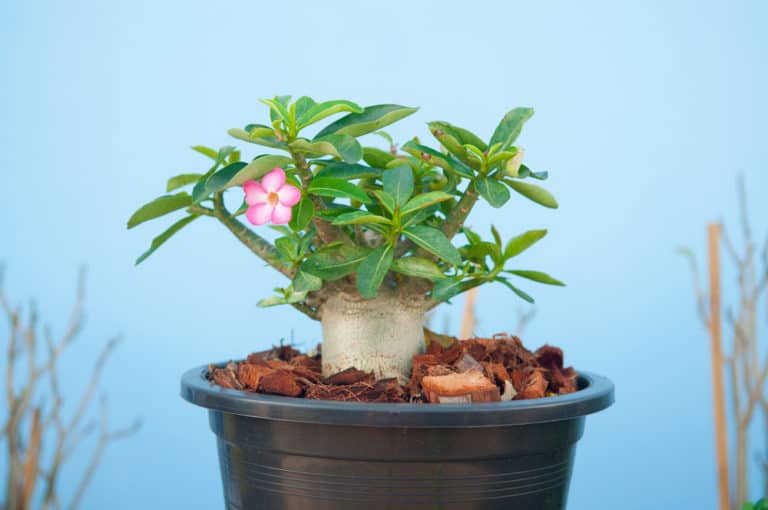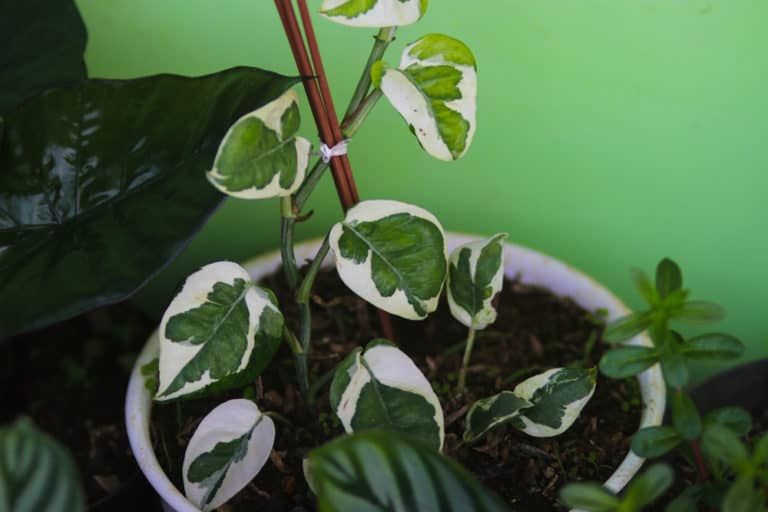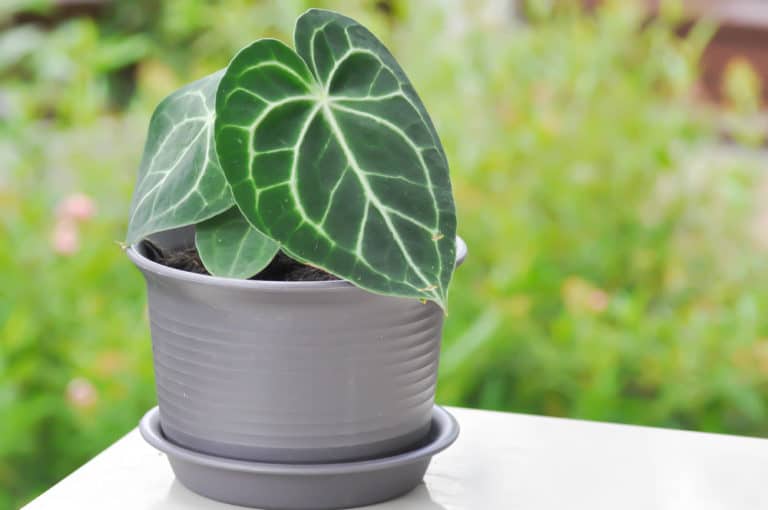Dracaena Marginata ‘Dragon Tree’ Care Guide (2024)
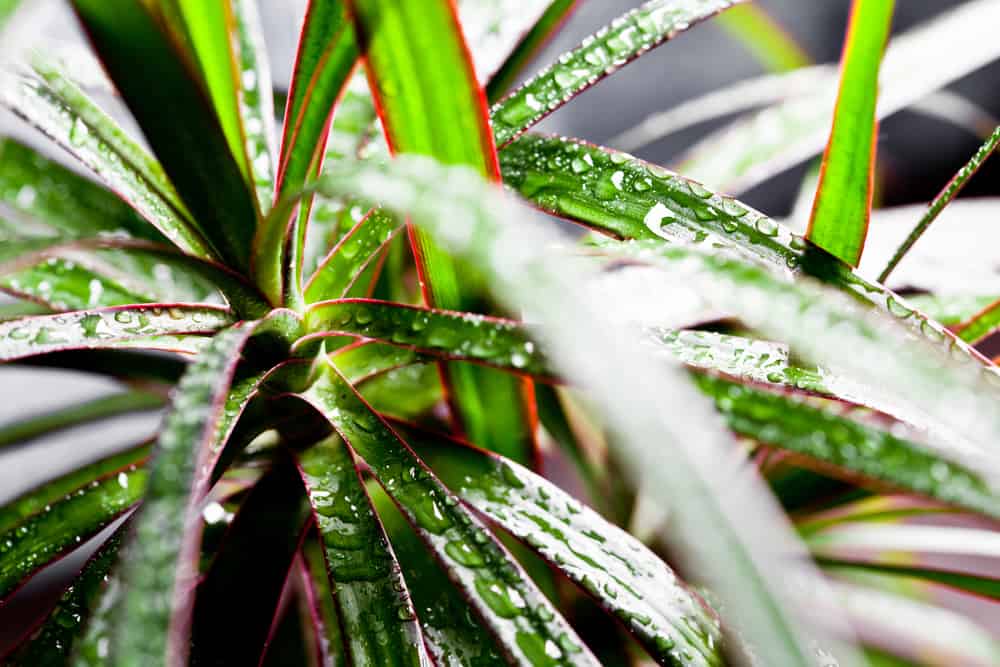
Dracaena marginata, commonly called the Dragon Tree or Madagascar Dragon Tree, is a tough tropical plant that will survive with little care.
Its spiky leaves and tall form can stand alone as an architectural shape in even a small room, or be an effective backdrop to a larger indoor garden.
| Scientific Name | Dracaena reflexa var. angustifolia |
| Common Name | Dragon Tree, Madagascar Dragon Tree |
| Light | Bright indirect sunlight |
| Watering | Water if the top half of the soil is dry |
| Temperature | 70 to 80ºF (20 to 27ºC) |
| Hardiness Zone | 10a, 10b, 11a, 11b, 12a, 12b |
| Humidity | 40 to 60% |
| Soil Type | Quick-draining, loamy |
| Soil pH | 6.0 to 6.5 (mildly acidic) |
| Fertilizing | A balanced feed at the beginning of the growing season |
| Repotting | Every 2 to 3 years |
| Pruning | To remove dead or damaged leaves |
| Propagation | Root in water |
| Toxicity | Toxic to pets |
| Mature Size | 6 feet as a houseplant |
| Bloom Time | Late Spring |
What’s Unique About Dracaena marginata?
The Dracaena marginata plant is native to Madagascar and Mauritius, two tropical islands in the Indian Ocean off the African Coast.
Dracaena marginata plants have adapted well to being grown as potted plants indoors in temperate climates.
Growing Dracaena marginata is easy, even for beginners, as it requires little in the way of regular care.
At the same time, its slender, striped leaves that grow atop the small tree can add a great deal of visual interest to your home or office.
Even better, Dracaena marginata will filter contaminants such as xylene, trichloroethylene, and formaldehyde from your indoor air, creating a healthier environment.
Dracaena marginata Care
On the tropical islands where Dracaena marginata originates, it is accustomed to hot temperatures, high humidity, and intermittent drought.
However, one of the great things about Dracaena marginata plant care is that this tough plant is tolerant of less than ideal conditions.
Dragon Tree care is mostly about keeping it in warm temperatures with average humidity.
Light
Dracaena marginata light requirements are fairly easygoing.
Ideal Dragon Tree light needs are for bright, indirect light, or between 10,000 to 20,000 lux.
You can usually find a good spot for a Dracaena marginata in a north or east-facing window, or several feet away from a south or west window.
Always keep your Dracaena marginata out of the full sun, which can burn the leaves and eventually kill the plant.
While a Dracaena marginata can tolerate a shadier location, the new leaves may lose their variegation. As well, it is less likely to bloom when it doesn’t get plenty of bright light.
Watering
In its native habitat on Madagascar, Dracaena marginata is used to prolonged periods of drought, with occasional soaking rains.
As a consequence, you should only water Dragon Tree when at least the top half of the soil is dried out.
The most effective Dracaena marginata watering is to set the whole pot in a pail of water. Wait until the soil is fully saturated, and then let the excess water drain out before replacing it in its saucer.
Dracaena marginata’s watering needs are best met with distilled water or rainwater, as the chemicals in treated tap water are harmful.
If you must use tap water, let it sit overnight to allow the fluoride and chlorine to dissipate.
Temperature
Madagascar and Mauritius are hot places. Temperatures range between 75° to 95°F(25° to 35°C).
While this may be the ideal Dracaena marginata temperature range, you do not need to provide that high a temperature for Dragon Tree. They will happily adapt to 65°F(18°C) and above.
However, Dracaena marginata has limited temperature tolerance below that temperature. Any length of exposure to temperatures below 50°F(10°C) will seriously harm the plant.
Keep it out of drafts, and in hot summer weather avoid placing it near air conditioning vents.
Like most tropical plants, Dracaena marginata has no frost hardiness at all. Freezing temperatures will kill it.
Humidity
The humidity level in Madagascar rarely falls below 80%, so that is the ideal humidity for Dragon Tree.
Luckily, though, Dracaena marginata humidity requirements are much more flexible than that.
Dracaena marginata will grow just fine at normal household humidity levels, but there are a few things that you should consider.
First of all, if the tips of your Dracaena marginata’s leaves start to turn brown and brittle, that’s a sign that it’s too dry even for this accommodating plant.
Secondly, if you want to see flowers on your Dracaena marginata, that is only likely to happen with a higher humidity level.
Daily misting or using a small humidifier will help improve the humidity for your Dracaena marginata.
Soil
Dracaena marginata soil should be loose and quick-draining, with some organic matter to feed the roots.
The best pH level for Dragon Tree is from 6.0 to 6.5, or mildly acidic.
It is not difficult to put together your own soil mix for your Dracaena marginata. You can mix standard potting soil with a scoop of lava rock, or add a handful of well-rotted compost to peat and use that as your potting mix.
Whichever soil for Dragon Tree that you decide to use, make sure that it’s got an open structure to allow the roots to breathe.
Fertilizer
Dracaena marginata needs very little in the way of feeding, but you should use Dracaena marginata fertilizer a couple of times a year.
The best times for fertilizing your Dracaena marginata are early spring when its growing season begins, and again towards the end of the summer.
A fertilizer ratio of 3:1:2 will encourage healthy leaves, which are the main attraction of Dracaena marginata.
Well-rotted compost is a good fertilizer for Dragon Tree. Just spread a thin layer on top of the soil.
If you use a commercial liquid fertilizer, apply it evenly to the soil right after you’ve watered.
Potting & Repotting
Because it is so slow-growing, repotting Dragon Tree is only necessary every 2 or 3 years.
It’s time for Dracaena marginata repotting when you see the quality of the soil going downhill, or roots starting to coil around the sides and growing out the bottom.
Only increase the pot size when it has become rootbound. Otherwise, you just need to change the old soil for fresh potting soil.
If you add compost, you won’t need to use fertilizer.
If you do need to move up, just go up one pot size, or at most 2 inches across. It’s also very important that the new pot has good drainage.
Pruning
Most Dracaena marginata pruning is just removing old leaves as they die, but you may also do some more adventurous pruning.
Whenever you find that your Dracaena marginata has grown too tall, or that it’s showing too much stem, you can cut the main stems back.
New stems will develop at the cut, and you can keep however many as you wish to grow.
When cutting Dragon Tree, use sharp, sterilized scissors or knives to trim.
Dracaena marginatas are often used to create bonsai, which involves years of careful pruning and training to achieve a miniature plant with intricate branches. It’s not something that you want to try as a beginning grower, however.
Propagation
Dracaena marginata propagation can easily be done with top or stem cuttings.
To propagate Dragon Tree from top cuttings, simply take the rosette growing right at the top of a stem, with about 2 inches of stem attached.
For stem cuttings, cut the stems into 12 inch lengths, ensuring that each has several nodes. Mark carefully which end is the bottom and which the top.
With either type of cutting, dip them in rooting hormone and place either in a jar of water or moist soil.
Keep them in a warm, humid spot out of the direct sun, and within a month or two you should have leaves growing at the top and roots at the bottom.
Common Problems of Dracaena marginata
There are not many potential Dracaena marginata problems, but even this low-maintenance plant can fall victim to pests or disease.
Other problems with Dragon Tree can be resolved just by improving its growing conditions.
It’s a good idea to keep an eye on the health of the leaves, as that’s the best way to catch problems early.
Pests
Dracaena marginata pests can cause serious damage if you can’t get them under control.
You can usually prevent them from ever turning up by using organic insecticides on a regular basis. Spraying the leaves with neem oil or insecticidal soap should keep most bugs away from your Dragon Tree.
Scale insects look like small brown bumps on the stems and leaves. Scrape them off.
Spider mites leave tiny white and yellow spots on the tops of the leaves, and sometimes spin sticky webs. Rinse the foliage in the shower.
Mealybugs look like little tufts of cotton under the leaves. Wipe them off with rubbing alcohol.
Diseases
The most common Dracaena marginata diseases develop as a result of poor watering practices. If you water only when the soil is more than half dry, and do not let the foliage stay wet, your Dragon Tree should stay healthy.
Root rot will cause leaves to turn yellow and stems to get mushy. You need to pull the root ball out of its pot and cut out all blackened roots, as well as the affected stems and leaves.
Replant your Dracaena marginata in fresh, porous soil after sanitizing the pot to kill the fungus.
Leaf spot can be identified by black spots with yellow edges. This is caused by wet foliage. Cut off all affected leaves.
Growing Problems
Some growing problems don’t involve disease or insects. You just need to improve your Dracaena marginata’s growing conditions to heal your sick plant.
If your Dracaena marginata has brown leaf tips, this could be a reaction to fluoride in the water or low humidity. Use water without fluoride, and raise the humidity level.
Browning, soft leaves indicate that your Dracaena marginata is too cold. Move it to a warmer spot.
If its leaves are small, it’s probably not getting enough light. Move it to a less shady spot.
On the other hand, if the leaves are dry and washed-out, it’s getting too much sun.
Toxicity of Dracaena marginata
Dragon Tree is toxic to cats and dogs, but not usually considered poisonous to humans.
However, even with a lack of toxicity for humans, care should be taken, especially around children, as some people can have an allergic reaction.
As always, it is better to prevent ingestion than to deal with the consequences.
For Humans
Dracaena marginata is not usually considered toxic to humans, but that does not mean that it is completely safe, especially for children.
All parts of the plant contain saponin, which can cause vomiting or diarrhea when ingested.
Children are extremely unlikely to try more than a tiny bite, since it tastes terrible, but they may still suffer a mild reaction of localized pain around the mouth.
If they develop more serious symptoms, take them to the emergency room.
Adults are more likely to react to the sap on the skin, which can cause a rash. Rinse it off your skin with soap and water.
For Pets
Dracaena marginata is considered extremely toxic to pets, especially cats and dogs.
Symptoms of saponin poisoning include vomiting (sometimes with blood), diarrhea, and excessive drooling.
Cats may also have dilated pupils.
If your pet has eaten some Dracaena marginata and is showing any of thes symptoms, take it to the veterinarian for medical assistance.
If you do want to keep a Dracaena marginata plant in a home with children and pets, find a place for it where it will not be accessible. When it is small, a shelf or table will probably suffice.
You may be able to fence it off with an attractive trellis at floor level.
Dracaena marginata Appearance
The Dracaena marginata appearance is striking, with its tree shape and long, elegant leaves.
You may even be lucky enough to see it bloom, if you can give it exactly the right growing conditions.
However, for most indoor growers, the elegant shape and exotic look of Dracaena marginata more than suffice.
Foliage
The foliage of Dracaena marginata is evergreen, meaning that the leaves remain on the tree even during its winter dormant period.
Each sword shaped leaf can grow to 2 feet long and half an inch wide, arranged in rosettes emerging from the growing tip.
The glossy green leaves have bright pink-red edges running the length of each blade, sometimes with yellow and white stripes framing a center strip of green.
Leaves will die from the bottom of the plant up as it grows, revealing the stem.
To maintain the attractive look of the leaves, they should be wiped down periodically to remove dust.
Flowering
Dracaena marginata flowering is more likely on plants grown outside in tropical regions, but it is possible to have a blooming houseplant.
To do that, you first have to provide it with ideal growing conditions of bright but indirect light, high humidity, and keeping it fairly root-bound in its pot.
Then, after about 10 years, you might see some flowers.
However, not everybody appreciates Dracaena marginata flowers. The small white flowers, appearing in late spring, have a scent that some find unpleasant.
As well, they drip a sticky nectar that can become a nuisance to clean up.
On the whole, you should probably be satisfied with the striking foliage of your Dracaena marginata.
Size and Growth
The mature size of Dracaena marginata when grown indoors is about 5 to 6 feet, with a spread of 3 feet.
It has a slow growth rate, taking up to 10 years to reach that height.
While a young Dracaena marginata will have a bushy appearance, as the plant grows and the lower leaves drop off, the stem will start to resemble a tree trunk.
It is topped with a canopy of rosettes of leaves, growing on two or more stems out of the main stem.
When grown outdoors in a tropical region, a mature Dracaena marginata can reach 12 feet or more in height.
Dracaena marginata Fragrance
The only time there is any Dracaena marginata fragrance is when the flowers are in bloom, which happens rarely indoors. There is no fragrance produced by the evergreen leaves.
The scent of Dracaena marginata flowers is appreciated by some, while others find it unpleasant.
Some people actually find that it can trigger headaches.
If you like the scent of Dracaena marginata flowers, it might be a worthwhile effort to encourage blooming so that you can enjoy it.
However, if you don’t like it, you can cut the flower stalks off as they form. This also has the advantage of concentrating the plant’s energies on leaf production.
Suggested Uses for Dracaena marginata
Dracaena marginata is a very popular plant for growing indoors, and with good reason.
Not only does it have a striking architectural appearance, but it is also very low-maintenance and long living.
Additionally, its ability to filter contaminants from the air makes it an excellent choice for use in a space such as a bedroom where good air is a bonus.
It takes up little floor space while adding good vertical interest, so it will fit into even a small studio apartment.
In summer, you can move it out to a shady balcony or deck as part of a tropical oasis.
FAQ
What is Dracaena marginata?
Dracaena marginata is a small evergreen tropical tree native to Madagascar and Mauritius. It is a popular houseplant for its low maintenance and exotic looks.
How to identify Dracaena marginata?
Dracaena marginata has narrow 2 foot long leaves with vertical stripes in green, red, yellow and white. It grows into a small tree with multiple stems.
How to care for Dracaena marginata?
Dracaena marginata should be kept in bright but indirect light, in porous soil and kept in a warm, moderately humid environment. Water and fertilize infrequently.
How to grow Dracaena marginata indoors?
Dracaena marginata can be grown indoors as a potted plant, kept in a warm spot with moderate humidity and watered only when the soil is half dry.
How to grow Dracaena marginata outdoors?
Dracaena marginata can be grown outdoors in tropical regions, where it should be planted in semi-shade in porous, well-drained soil. Only water when it hasn’t rained for a month.
How fast does Dracaena marginata grow?
Dracaena marginata has a slow growth rate, growing about half a foot a year, reaching its full height of 5 to 6 feet in 10 years.
How tall does Dracaena marginata grow?
Dracaena marginata will grow to a height of 5 to 6 feet when grown indoors, while outdoors plants can mature at more than 12 feet.
How to make Dracaena marginata grow faster?
Dracaena marginata will grow the fastest when grown in an environment with warm temperatures, high humidity of 80% or more, and bright, indirect light.
How to stake Dracaena marginata?
Dracaena marginata does not need to be staked, as the stiff stems are self-supporting. Sometimes two stems will fuse together when growing right next to each other.
How to pot Dracaena marginata?
Pot Dracaena marginata in a pot with good drainage holes, in porous, loose soil that will let the roots breathe. An unglazed pot will help dissipate any extra moisture in the soil.
How to revive Dracaena marginata?
If your Dracaena marginata has completely dried out, plunge the pot into a pail of water until the soil is saturated. Then let the excess water drain completely.
Why is my Dracaena marginata dying?
Your Dracaena marginata may have a fungal or bacterial disease caused by overwatering. Cut out all affected parts and repot in a fresh soil mix.
Why is my Dracaena marginata drooping?
Your Dracaena marginata may be in sopping wet soil, or soil that has dried out. Either replant it in fresh, porous soil, or water thoroughly.
How cold can Dracaena marginata tolerate?
Dracaena marginata will not grow well at temperatures below 50°F(10°C) for any length of time, and exposure to freezing temperatures will kill this tropical plant.
How to get rid of pests on Dracaena marginata?
Dracaena marginata pests can be eliminated by scraping, rinsing, or wiping them off, and then discouraged from returning with insecticidal soap or neem oil sprays.
Is Dracaena marginata toxic to cats?
Yes, Dracaena marginata is toxic to cats. If your cat is drooling, has dilated eyes, or is vomiting, take it to the veterinarian for care immediately.
Is Dracaena marginata toxic to dogs?
Yes, Dracaena marginata is toxic to dogs. If your dog has diarrhea or is vomiting or drooling excessively, you should take him to the vet at once.
Is Dracaena marginata toxic to children?
Dracaena marginata can be toxic to children if eaten in sufficient quantities. If your child has diarrhea or is vomiting, take them to the emergency room.
Is Dracaena marginata toxic to humans?
Dracaena marginata is only mildly toxic to adult humans. If you have sensitive skin you may develop a rash from the sap, so take precautions when handling the plant.
Does Dracaena marginata have a scent?
The rare Dracaena marginata flowers do have a strong scent that some people like and others find unpleasant. The foliage has no fragrance at all.

